5 Types of Solid State Drives [Connectors Type Explained].
One of the innovations in storage for laptops and desktops has been the incorporation of SSD types. But not all types of solid state drives and SSD connection types are the same, nor can they be incorporated into any computer.
The solid-state drives present some evolutions in relation to Hard drives. A solid-state disk is faster, more durable, and in some cases smaller than traditional HD, but the variety of brands and types of SSDs makes a choice a little tricky.
Installing an SSD is an upgrade more than recommended for most users, especially on laptops, so much so that most of them already have an easy-access port for installing an SSD. But there are still some questions about these devices.
To make things easier, I present the types of SSD and indicate how to choose the SSD that will equip your computer. In this article, you will figure it out thoroughly: what types of SSD drives exist, types of SSD connectors and connection types, and an SSD form factor in an easy-to-understand manner.
What is a Solid State Drive (SSD) in SImple Words?
A solid-state drive or SSD is a new, more modern device for storing information compared to mechanical (HDDs) counterparts. The term “Solid State” actually refers to using solid material to carry electrical signals between transistors instead of a passageway based on vacuum tubes, as was done in the past.
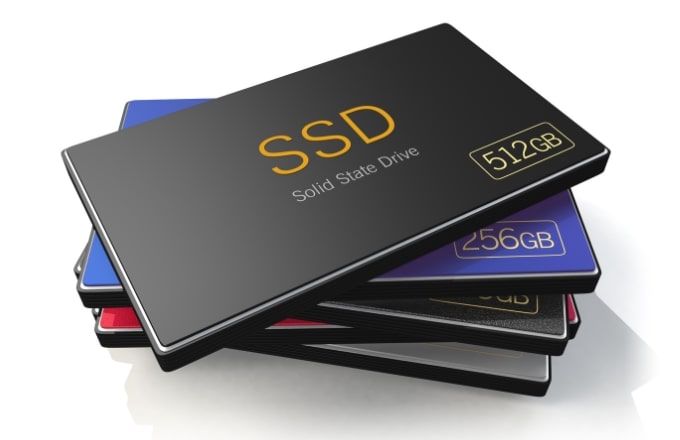
An SSD is a static device with no movable parts instead it is built with ICs (integrated circuits) to store the information inside an SSD. These storage devices are significantly faster than Hard Drives as your OS would boot it swiftly and load programs quicker.
In technical terms, SSD is a read-only memory device of a computer based on non-volatile memory chips controlled by a unique controller, totally dispensing with mechanical systems for its operation. As a result, units of this type end up being more economical in energy consumption; after all, they do not need to power supply/motors or similar components.
Also, SSDs are different in shape, and their internal components, but it works the same functions as our Hard drives. But if SSD and HDD have the same function, what’s the big difference between them? Let me show you:
SSD Components
To have a clearer view of the device, for a start, let’s take a look at what components a solid-state drive consists of:

How is an SSD Different from an HDD?
These are the metrics that differentiate an HDD from SSD:
- Read/Write Data
The HDD has a mechanical arm to read and write data, and its operation takes place magnetically by using magnetic systems (a technology similar to those used in CDs and DVDs).
In contrast, the SSD is built around a semiconductor integrated circuit, is responsible for storage, and has flash memory (a technology similar to those used in memory cards and USB sticks). This makes SSDs essentially different from HDDs. This circuit also assists in caching, cleaning, storing, and restoring data.
- Build:
The main difference from SSDs to HDDs is that the SSD has no moving parts, making it anti-vibrating and shock-proof, while conventional Hard Disk uses a magnetic disk that runs a certain amount of times per minute. This makes writing to these devices slower and more likely to damage as many fragile components wear out over time.
Because SSD works electrically, it can make reading and writing function faster and quieter, increasing the useful life of flash memory and managing the cache for reading and writing files.
- Heat Resistance:
SSDs are more heat-resistant prevents happening overheating of computer/CPU than HDDs because of the components on HDD that heat quickly.
- Processing Speed:
Since SSDs have no moving parts and in addition to making them more resistant than HDs, access to files and operations are done through electricity, representing a noteworthy decrease in the operating time of these functions compared to Hard Disk, (However there are some effective ways to speed up your hard drive such as defragmentation of hard disk). But never defrag SSD.
That’s why solid-state drives can speed up the file transfer from 10x to 20x faster than HDD. The processing speed for SSD can go up to 3500 Mbps, while HDDs only limited up to 160 Mbps.
- Weight:
SSDs are lightweight while HDDs are a bit heavier. Even the portable external SSDs drives light weight than external HDD.
5 Types of SSDs (Solid State Drives) with Connectors
Now that you know what SSD is and how it differs from a hard drive, it’s time to know the types and formats of Solid State Drives. Today, there are five most common SSD form factors used in the commercial segment.
Let’s see what interfaces, power connectors, form factors, and functionalities exist for SSDs in today’s market.
1. SATA SSD (SATA I, II, III)
SATA is the acronym for ‘Serial Advanced Technology Attachment’. Speaking of SSD types, SATA-type SSD is the most popular today and also one of the first SSD models to hit the market. It has a dimension of 2.5 inches, the same size as the conventional HD, and the same connector type.
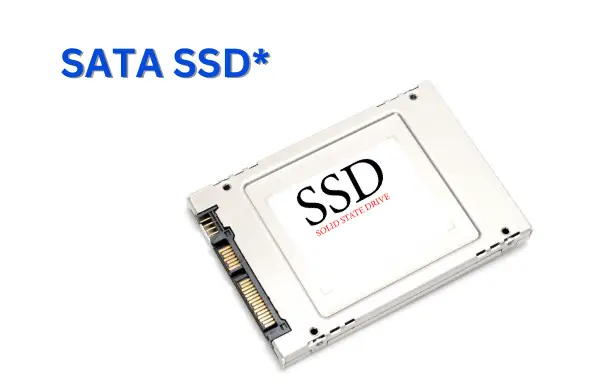
As a connection interface, SSD uses SATA (Serial ATA) to communicate data with the system. If you own a SATA SSD, I can almost guarantee that it can be used with any desktop or laptop you have now, even if that computer is ten years old.
SATA-based SSDs are also more suitable for older computers that lack newer SSD connector types and only have SATA connections. A great way to speed up an older laptop or desktop is by replacing the old spinning hard drive with the new solid drive, increasing the computer’s ability to read/write data, possibly five times.
SATA is a model that has been constantly changed and has reached three main versions: SATA I, SATA II, and SATA III. The transfer rate of all three versions of SATA data cable is given below:
- SATA 1.0: 5 Gb/s, 150 MB/s
- SATA 2.0: 3 Gb/s, 300 MB/s
- SATA 3.0: 6 Gb/s, 600 MB/s
For installing the SATA SSD (I, II, III) on your laptop or desktop, you need a 2.5 Inches Drive Bay and a SATA data Cable and SATA power cable.
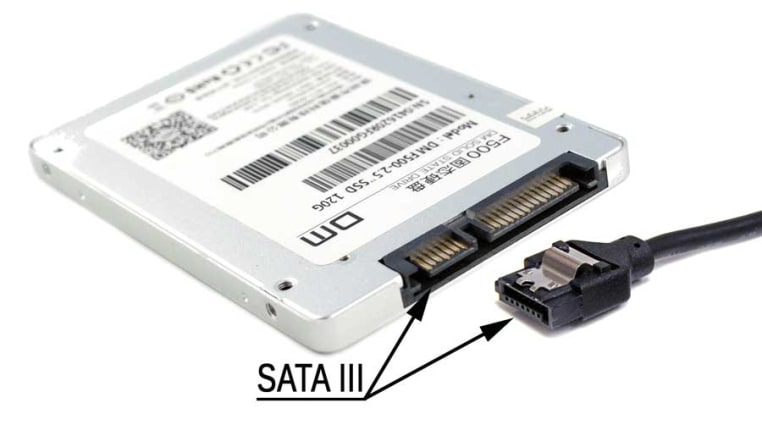
Do you know, Hard Disk Drives uses the SATA connection, so either SSD or modern HDD from laptop to desktop based on SATA interfaces.
2. M.2 SATA SSD
The M.2 type of SSD is newer, and its format is lighter and smaller than the SATA type SSD. M.2 SSDs consist of a small printed circuit board with chips, somewhat reminiscent of a regular DDR4 or DDR5 RAM bar shape.
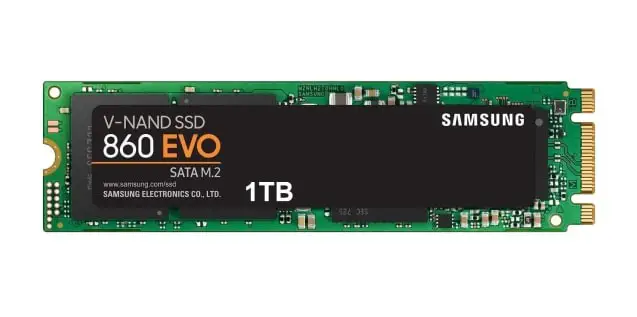
Most M.2 drives are 22mm in width and 80mm in length with NAND chips on both sides. M.2 SATA drives are simply more convenient, as they are installed in a slot on the motherboard and do not require wires, but on the motherboard of the PC or laptop must have an appropriate M.2 slot.
Another advantage of the M.2 is its format flexibility, making this drive used on small laptops and desktops. These devices are very similar to small plaques, 22 mm wide but with different lengths: 22 mmx60 mm, 22 mmx80 mm, and 22 mmx110 mm. Thus, M.2 SSDs are specified as 2230, 2242, 2260, 2280, and 22110.
Here is a summary of the various most common M.2 formats and their respective sizes:
M.2 22110 : 110 x 22 mm
M.2 2280 : 80 x 22 mm (perhaps the most common)
M.2 2260 : 60 x 22 mm
M.2 2242 : 42 x 22 mm
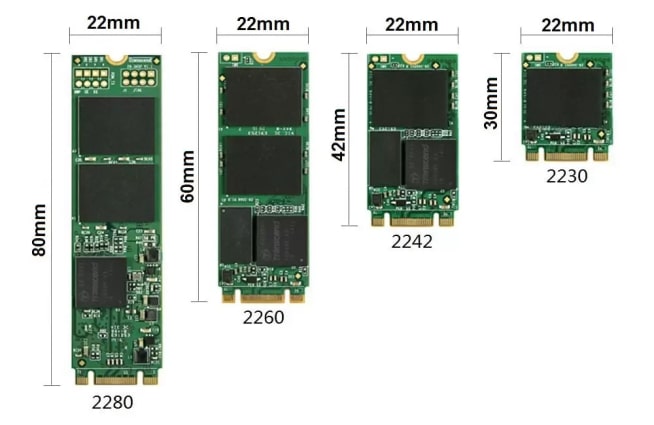
And the speed of the M.2 SATA SSD is the same as the regular SATA SSD has, i.e. up to 600 MB/s.
Important Note: The M.2 slot on some motherboards of Desktops and laptops can accept either the SATA bus or the PCI-E bus, i.e. such devices have either M.2 SATA slot or M.2 PCI-E slot. But on separate motherboards, M.2 slots can serve only one of them; either M.2 SATA mode or M.2 PCI-E mode. That’s is why you need to find out; is your computer is compatible or not for M.2 SATA SSDs.
And, accordingly, you can connect either M.2 SATA drives or M.2 PCI-E drives to such motherboards.
The connectivity of M.2 type SSDs is more complicated, but it can be done in 3 ways, depending on the type of socket on the motherboard.
The M.2 interface can have three key variations:
- Switch B
- Switch M
- Switch B&M
If you purchase an M.2 SATA (B&M) SSD and the motherboard supports M.2 PCI-Express (B&M), the SSD will not work! The M.2 slot keys on the motherboard and laptop must match the M.2 SATA slot as well as the size of the drive.

When buying a drive with an M.2 connection, it is essential to understand very accurately what kind of slot we have on the motherboard of a PC or laptop – what interface it is for, what key it has, and what sizes of drives it supports. Also, use M.2 heatsinks when temps reaches 70 degrees or more.
Also Read: Can you connect a M.2 SSD drive to a Regular SATA or USB port?
3. mSATA SSD
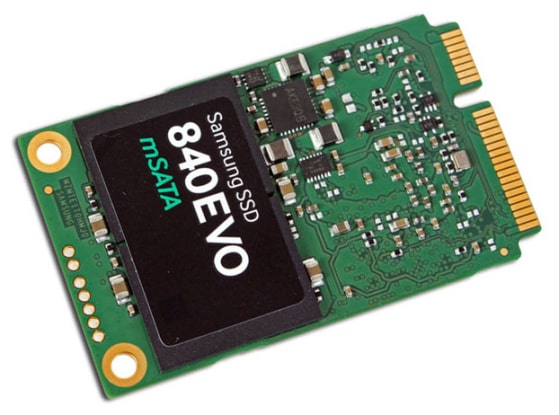
An mSATA SSD is the mini version of SATA. It has a smaller form factor mainly used in ultra-compact computers, laptops, and mobile devices (tablets) with an mSATA slot, in which the installation of an extended size SATA SSD is impossible.
The latest mSATA has a capacity of up to 1TB and a read/write speed of up to 6gbps. mSATA has lower power consumption. The performance is not lesser than SATA SSD as well as, the price is very economical.
Drives of this format represent a small card with soldered microcircuits installed in unique slots of some devices. The main advantage of mSATA is its miniature; however, it is the same SATA SSD in all other aspects. Experts recommend purchasing such drives only for upgrading those devices in which the mSATA connector is provided.

The mSATA connector on laptops is now virtually ousted from the market by the M.2 connector. Yet there are very few mSATA drives themselves on the market.
4. M.2 PCI-E SSD
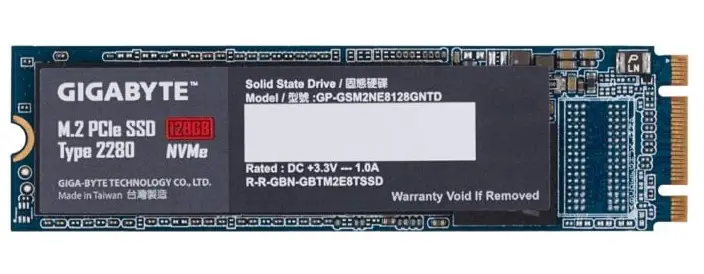
PCIe is one of the solid-state drives type connected to a computer system using a PCIe interface, which has become a new way to increase the speed of servers and storage devices.
PCIe-shaped SSDs fit into ports on your motherboard graphic card, the same way you install internal audio or network cards/components. And when you use NVMe SSD using PCIe SSD, you get the fastest computational speed. Its max read/write bandwidth is 2000mbps and can support up to 32gbps.
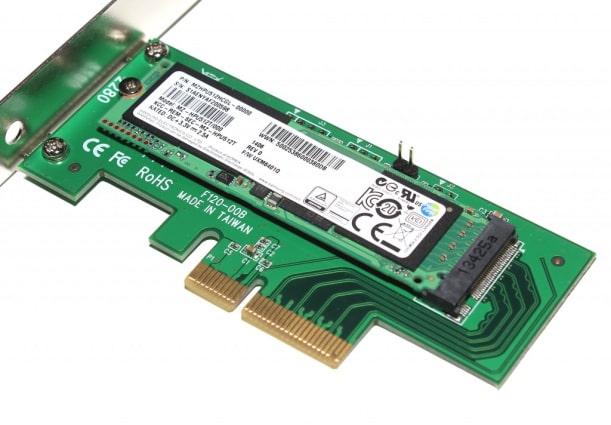
PCI Express SSDs are often costly, which is why they are usually only used in high-performance applications. You can also find other types of smaller SSDs that use the PCI Express (PCIe) connection, allowing a data transfer rate up to 4 times higher than the SATA 3 SSD.
For installing PCIe SSDs, you need PCIe M.2 slots on your motherboard. The M.2 slot keys on the motherboard must match the keys, as well as the size of the M.2 slot, and the M.2 drive must be the same size.
5. M.2 NVMe SSD
NVMe is a type of SSD that stands for Non-Volatile Memory Express (NVMe) is five times faster than SATA SSDs due to its protocol for SSD that allows data exchange speeds up to 2600mbps. NVMe SSDs came later than SATA ones, and these slots were initially designed for graphics cards, so they are incredibly fast.
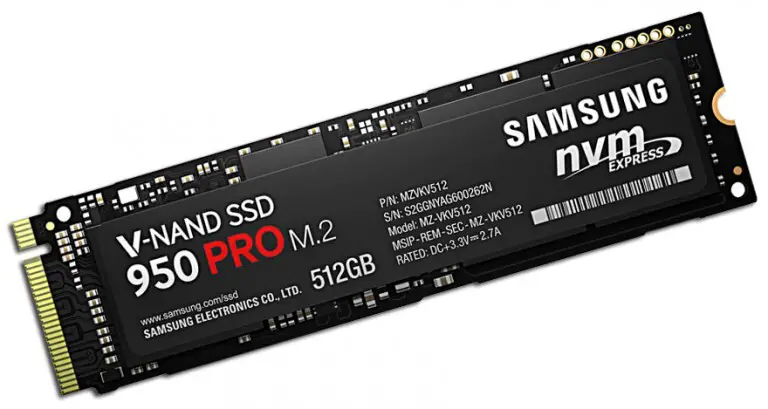
The objective here is to increase the unit’s performance. An M.2 NVMe SSD can have more data transfer speed (compared to a SATA SSD) due to the connection of this protocol with PCI Express, the latest and fastest technology.
They are more expensive than SATA and consume more power. High-scale businesses, intensive functioning computers, and large servers use NVMe. It also works with flash memory as well as reducing I/O Bridge and latency.
Speeds on NVMe drives can reach an interface rate of 32 Gb/s with 3.9 GB/s throughputs. That can be very useful if you’re doing something that requires a lot of disk performance, like gaming or high-resolution video editing. It has a storage capacity of up to 4TB.
For installing PCIe NVMe, you need a motherboard most of the time with the form factor of PCIe, M.2, U.2.

As fast as it is, NVMs have some drawbacks:
If the latest and greatest speeds and efficiencies that come with an NVMe SSD are a must, then there are a couple of things to keep in mind.
Which SSD type is fastest?
NVMe PCIe SSDs are the fastest having more bandwidth while transferring data as well as writing/reading. The speed and performance of NVMe PCIe are 3 to 4x times faster than SATA SSDs and 10 to 20x times more than SATA HDDs, which makes them the fastest SSD.
Disc Type | Maximum data reading speed |
SATA HDD | 160 MB/s |
SATA 3 SSD | 600 MB/s |
NVMe PCIe SSD | 3500 MB/s |
You can step out of your traditional HDD and buy a better SSD for your PC if your primary interest is in faster-performing storage.
Pros and Cons of SSD Drives over HDDs
Here’s the comparison table between an SSD and an HDD:
Factor | SSD (Solid State Drive) | HHD (Hard Disk Drive) |
Speed | Faster | Slower |
Sequential Read Speed | MB/sec | 150-1350 |
Number of Reboot Cycles | 3000-10 | 000 |
Power Consumption | Lesser | More |
Movable Parts | No | Yes |
More resistant against physical shocks. | Yes | No |
Size | Compact | Big |
Storage Capacity | Limited | Extended |
Maximum Capacity | 500MB - 4TB | Up to 22TB |
Cost | Somewhat Expensive | Affordable |
Form Factor | SATA 2.5, M.2 SATA, mSATA.,2.5- 3.5 | 2.5 or 3.5 inches |
Due to its fast read-write data and resistance to physical and magnetic damage, the decision to buy an SSD drive for a PC or laptop or even Chromebook if available will be an excellent option for upgrading your computer.
Of course, SSD drives are more expensive than hard drives, although prices decrease as their usage increases. Because of this — in many cases and due to technological limitations — the vast majority of SSD drives offered on the market have much lower storage capacity than hard drives in the same price range.
What is the difference between Expensive and Cheap SSD?
There could be striking differences in the quality of SSDs we buy from the market. There are some high-profile ones, while some of them are on a budget. Here are some aspects we can look into to know the difference:
1. Age: A good SSD can cost you more, but they also protect you from wearing out soon. An expensive SSD could function for more than 20 years; meanwhile, a cheaper SSD would wear out soon after 5 to 10 years.
2. Faster Tasks: Tasks are done slightly faster on expensive SSDs. The reason is the faster loading of the SSDs, which gives them an advantage.
3. Cell-Level: The most commonly used SSD is the triple-level cell or TLC, and it has a higher chance of failure. It’s the cheapest option too. Others are Multi-Level Cell and Single Level Cell, both being a bit expensive with more extended warranties and faster processing.
How to choose SSD and their types?
Before picking your SSD types, there are certain things you need to keep in mind:
- Budget,
- Building preferences,
- Motherboard of your laptop/desktop should be compatible, as like your CPU is compatible with motherboard,
- Performance needs.
For Modern PC:
If you have a desktop or laptop with modern or slightly older infrastructure, your system can support both M.2 and 2.5-inch drives. You can opt for one or even a combo – M.2 for the boot drive and latter for additional storage. It would reduce cable clutter and add blazing fast speed to your PC.
For Older PC:
For older desktops, you’ll be more likely to choose a 2.5-inch drive with some M.2 drives. If your PCB (motherboard) has PCIe 3.0 slots, then you can go for PCIe add-in adapter cards. It will allow you to accept M.2 drives too.
You may consider M.2 SATA SSD if you are updating your laptop and need fast storage of less than 2TB.
For an NVMe Drive:
The NVMe SSDs may work better for you if you’re building a high-end work center or gaming PC with no budget restrictions also if you want to create a server that will host a storage-intensive application.
Top Most Reasons to Buy an SSD
SSD drives have become famous for a reason, gradually replacing classic Hard Disk solutions. They have a wide range of qualities that ensure the speed and reliability of work. Therefore, the demand for them is constantly growing. Here are the reasons why you should buy SSDs:
FAQs
Does it matter what type of SSD I get?
Yes, different types of SSD will have a different impact on your computer’s performance. It will affect the boot time, programs loading, and compatibility. SSDs have varying life spans, too, so their longevity will be different as well.
Can I use SSD and HDD at the same time?
Yes, one can use SSD and HDD together, and it comes with multiple benefits. You get faster loading speed, low energy consumption, and a backup option for your essential files. Use SSD for quick loading and HDD to keep large files.
What is SATA Express Connector?
The SATA Express connector is a hybrid connection, which combines the SATA standard with the possibility of plugging directly into the motherboard through PCIe x1 or x2 ports. The exciting thing about this approach is that if a SATAe slot is not in use on the motherboard, it can connect up to two devices via “normal” SATA, thus achieve better performance—something similar to RAID. This technique makes the system faster and more secure. Theoretically, SATA Express can achieve data transfer rates of up to 16 Gb/s.
What is U.2 SDD and U.2 connector?
U.2 SSD comes with a U.2 interface (formerly known as SFF-8639) and is an interface standard defined by the SSD Form Factor Working Group (SWG). U.2 is developed for the enterprise market and supports PCI-E, SATA, SATA-E, and SAS interface standards, providing high data transfer rates. For an SSD with a U.2 connector to work, it must be provided by the computer’s motherboard.
Does SSD increase FPS?
Your SSD would not increase your FPS directly, but it will help prevent stuttering and hitching in heavier games. Storing the game on SSD storage will help quickly open and load the game and its maps.
Is a 256GB SSD better than a 1TB HDD?
If you are looking for more storage space on a budget, go for a 1TB HDD; otherwise, if you’re looking for fast computational speeds, a 256GB SSD would be perfect for you as it is still 4 to 10 times better than HDD.
Can you install an SSD on any laptop?
Yes, an SSD can fit inside any laptop, but you should check the dimensions and specifications to install the SSD properly from your laptop manual. Most laptops support 2.5-inch SATA SSDs.
Conclusion
Many people wonder if SSD technology signals the end of the hard drive era. It is hard to say. HDs still have a decent cost-benefit ratio regarding storage capacity, not to mention that these devices have satisfactory average durability.
SSDs have a higher storage cost, and hard drives continue to be refined to gain more capacity and durability. The two categories are likely to coexist “peacefully” for a long time to come.
I hope you are now cleared about SSDs and types of solid-state drives. Also, remember that I described their speed in best-case scenarios, and it can fluctuate and feel less-speedier sometimes.
Since it takes too much time and effort to deliver such an informative article, it will be grateful if you could share this article “5 Different Types of SSDs with Connection Type Explained” on social networks. Cheers!
